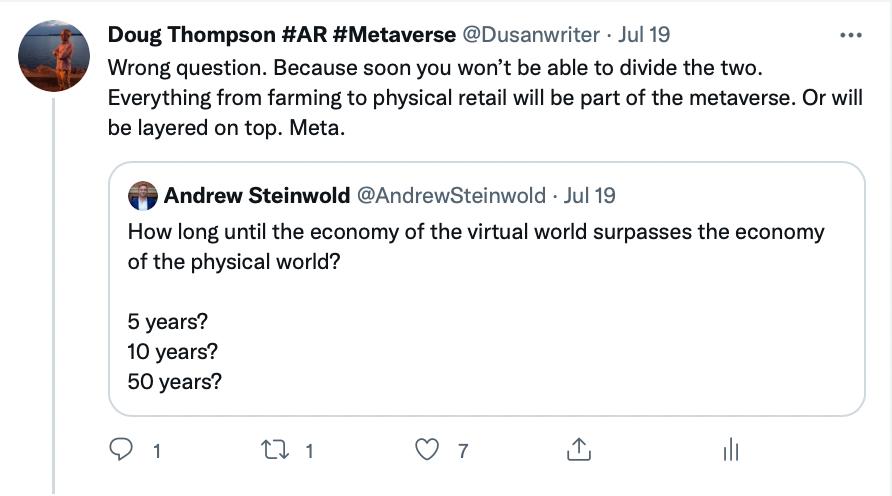Sketchfab, Epic and the Metaverse

Epic Games has bought Sketchfab. A further definitive sign that Epic intends to be the primary driver of the Metaverse.
If you're reading this, there's probably no need for me to outline the players. But jump over to Techcrunch or Engadget if you want a primer.
The short version: Sketchfab hosts a lot of 3D models and makes it easy to view, buy and use them; Epic is a game engine (and Fortnite). Or maybe Epic is Fortnite (and a game engine).
But this is about more than developers or marketplaces for 3D models. Because putting aside Epic's grand designs for the Metaverse, Sketchfab itself has created an important trajectory for our spatial computing future.
The Metaverse is Bigger Than You Think
There's a concept for the Metaverse. It's based primarily on two books. And it circles around the idea that at some point, we'll throw on a pair of VR goggles and we'll enter a universe which has a fidelity that matches our own.
Being a universe, it will have its own culture and economy. We'll be able to hang out in seedy bars or play...well, play some future version of Fortnite with our friends. We'll be able to earn a living, whether through some super-charged version of Axie Infinity or by sitting around in our virtual homes answering questions posed by the Mechanical Turk (while Bezos smiles down at us from space).
But I think this vision is too narrow. I'll take the most obvious reasons:
- Building out the "worldscape" of the Metaverse will take time. Fortnite island is small. And even if you bolt on No Man's Sky-type generative content, we're still a long way from moving beyond islands towards something truly expansive. And so this vision of a universe we log into is the biggest lift there is.
- This is fine. We don't NEED a universe-sized Metaverse. And yet it will still compete against a world which is already pretty darn huge: our own. You can layer a lot of really cool content on top of the physical world that we've already built. Therefore, a big chunk of how we experience the Metaverse can happen as we walk around downtown.
- The most successful franchises today are multi-platform. Which means that there is already a pipeline and movement towards experiences that bridge phones, VR headsets, television sets and future optical devices. VR is not how most of us will experience the Metaverse.
- The convergence of AI with spatial computing will facilitate worlds that look nothing like how we imagined them. It's feasibile that entire universes will exist that have their own cultures, economies, decentralized autonomous organizations (DAOs), autonomous avatars and reason for being ....that don't even particularly require any users.
Which speaks to a point I made on Twitter in response to a question about virtual world economies:

I've tried to write about this before. And I realizes it falls on deaf ears. But I still see no reason why we can't at least partly equate, for example, driving a Tesla (or Tesla driving us) as being an experience of the Metaverse. Your car, afterall, will soon become a physical, metal avatar moving through a digital space.
But there are two other reasons why the Metaverse won't be exactly how we imagine. And that's where Sketchfab comes in.
Because in buying it, Epic isn't just buying a marketplace for 3D content that can be used to populate the Metaverse. It's buying two other things which have a deeper value.
Sketchfab: Headless CMS for 3D Content
Epic has bought distribution. Sketchfab is a headless CMS for 3D content. Which means that better than any other platform in the world today, it is allowing content developers to distribute to the web or VR, to game engines or augmented reality.
Epic writes (bold added):
Sketchfab makes it easy to discover, edit, buy, and sell 3D content directly through their web-based service and is home to 4 million 3D assets. Their technology has integrations across every major 3D creation tool and publishing platform and is compatible across all major browsers and operating systems, on both desktop and mobile. By joining forces, Epic and Sketchfab will be able to make 3D, AR and VR content more accessible and grow the creator ecosystem, which are critical to an open and interconnected Metaverse.
Headless CMS has been around for a while. But it's really only gained significant traction in the last few years. And it's the idea that the content should be cleanly separated from its display.
You can write an article in Wordpress. And the article gets displayed within the Wordpress template. Sure, it looks OK on mobile. But it doesn't look so good as an Instagram story.
You can write a chunk of content in a headless CMS, however, and by semantically tagging that content it can be consumed by Instagram for a story, a blog site as a blog post, and as a snippet on a main page. The content doesn't care WHERE it will be displayed.
And that's what Sketchfab does.
And this is important, I think, because the Metaverse will be built in large part off of existing paradigms, technology stacks and frameworks.
As much as I'd like to just toss the whole Internet out and start over, there is a path- of-least-resistance to adapting what we've learned already to a world of spatial computing.
In buying Sketchfab, Epic has bought a distribution platform. It's like buying a company that can convert a theatre play into a movie, TV show and youTube clip with the touch of a button.
SketchFab Is A Memory Box
Epic recently purchased Capturing Reality which gave it a photogrammetry powerhouse. It was a natural extension of Quixel, which is a library of "megascans" used by developers.
But Sketchfab has become the place everyone else goes to post and share their scans.
We're not quite ready to assemble 3D photo albums of a wedding or our trip to Cancun. But it will come.
Because with photogrammetry now accessible to anyone with a decent phone camera (and at an even higher degree of fidelity if you also have LiDAR), we're about to achieve peak velocity for scanning.
Photogrammetry is to 2021 what the Polaroid was in the 50's: poised to become a cultural phenomenon.
In fact, if the only thing that Sketchfab did was distribute scans at the scale they do today, that alone would be worth the purchase price to Epic.
And this points to another shift in how we think about the Metaverse: that it will include both crafted and scanned content, that we will be able to create landscapes composed entirely of 3D images of our relatives or pets, or we will choose to live in accurate digital recreations of our own homes (and how meta is that?)
The lines between where and WHAT is digital and physical will soon cease to have meaning.
Everything will have a digital layer. Some of those layers will be private and walled off and used by enterprise, some of them will be accessible to everyone, and many of them will create new forms of inequality because you will need to be priviledged enough to afford the devices to see what might be critically important content.
Sketchfab captured something elusive: the first headless CMS for 3D content, which makes distributing a 3D asset as easy as hitting publish on a blog. And a place where amateur (and professional) communities, best practices and assets are being built around 3D scans.
Which means, by extension, that Sketchfab has created a toolkit for sharing stories about place.
Which, to me, is the primary definition of what the Metaverse will be.